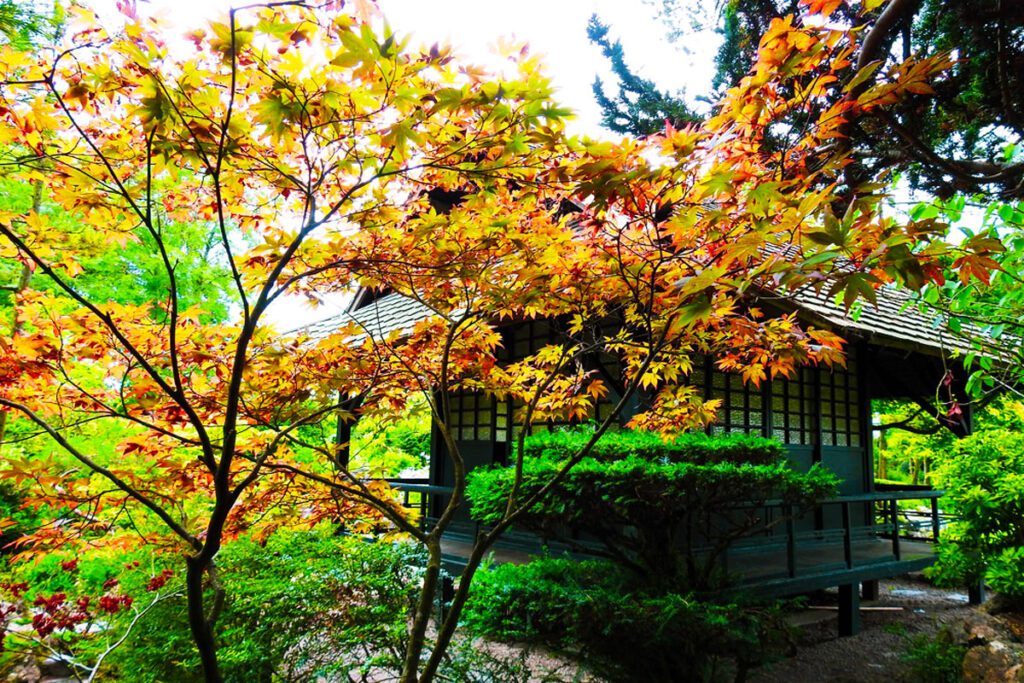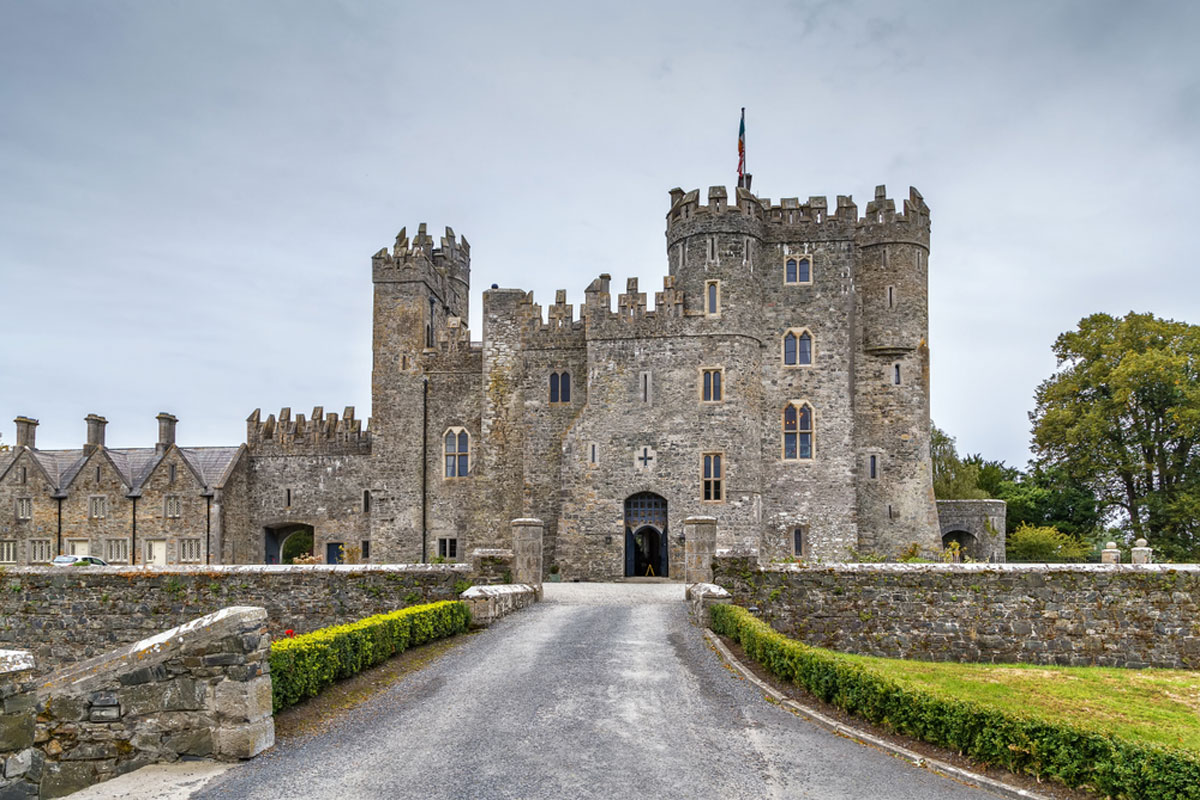The Genesis of the Gardens
Nestled in the heart of County Kildare, the Japanese Gardens at Tully stand as a testament to the harmonious blending of Eastern and Western cultures. Created between 1906 and 1910, these gardens were the brainchild of Colonel William Hall-Walker, a visionary Anglo-Irish horse breeder. He sought not only to enhance the aesthetic appeal of his stud farm but to create a spiritual haven that would symbolize the journey of life itself.
To bring this vision to life, Hall-Walker enlisted the expertise of master Japanese horticulturist Tassa Eida. Eida, along with his son Minoru, meticulously designed and constructed the gardens, imbuing them with the principles of Zen Buddhism and traditional Japanese gardening. The result was a series of interconnected spaces that lead visitors through a symbolic journey from birth to death, reflecting the transient nature of life.
The design of the Japanese Gardens at Tully is unique in Ireland. Unlike traditional European gardens that emphasize grandeur and symmetry, these gardens focus on simplicity, natural beauty, and the creation of peaceful contemplation spaces. Every element, from the placement of stones to the selection of plants, is intended to evoke a sense of tranquility and reflection.
A Symbolic Journey Through Life
The Japanese Gardens at Tully are more than a beautiful landscape; they are a carefully crafted narrative that takes visitors on a symbolic journey through the stages of life. The design of the gardens is rich in metaphor, with each section representing a different phase of human existence, from birth to death and beyond.
Visitors enter the gardens through the Gate of Oblivion, a dark, narrow entrance symbolizing the mystery and uncertainty of birth. This leads to the Cave of Birth, where the path is confined, mirroring the early stages of life when one is confined by the limitations of infancy.
As you progress, the path opens into the Tunnel of Ignorance, a space designed to represent the innocence and lack of knowledge in childhood. This section is followed by the Hill of Learning, symbolizing the struggles and challenges of adolescence and early adulthood. Here, the path becomes steeper, reflecting the effort required to gain wisdom and experience.
The journey continues to the Well of Wisdom, where the path levels out, representing the maturity of middle age, where one draws on accumulated knowledge to navigate life. The Bridge of Life is next, a key feature of the gardens that represents the crossing into the later stages of life. This red bridge, with its gentle arc, symbolizes the balance needed as one navigates through the complexities and responsibilities of adulthood.
The path then meanders through the Garden of Peace and Contentment, reflecting the tranquility and fulfillment often found in the later years of life. The final stages of the journey are marked by the Gate of Eternity and the Hill of Mourning, where the path ascends to a serene viewpoint, symbolizing reflection on life and acceptance of its end.
This journey is not just physical but deeply philosophical. The design of the gardens encourages introspection, inviting visitors to consider their own lives, challenges, and the passage of time. By walking the path, one metaphorically walks the path of life, experiencing the highs and lows, the struggles and peace that define human existence.
The Art of Horticulture and Design
The Japanese Gardens at Tully are a masterpiece of horticultural art, where every plant, stone, and water feature plays a significant role in the overall design. The careful selection and placement of these elements are rooted in the principles of Japanese gardening, which emphasize natural beauty, simplicity, and the creation of a tranquil atmosphere.
One of the core principles guiding the gardens’ design is the concept of Shakkei, or “borrowed scenery.” This technique involves incorporating the surrounding landscape into the garden’s design to create a seamless blend between the natural environment and the cultivated space. At Tully, the rolling hills and distant trees of the surrounding Kildare countryside serve as a perfect backdrop, making the gardens feel expansive and connected to the world beyond their borders.
The gardens are also meticulously structured around the principle of Wabi-Sabi, an aesthetic that finds beauty in imperfection and transience. This is evident in the aged stone lanterns, weathered wooden bridges, and carefully pruned plants, all of which are meant to evoke a sense of calm and acceptance of nature’s ever-changing state. The moss-covered rocks and the subtle, natural colors of the plants emphasize simplicity, encouraging visitors to appreciate the understated beauty that emerges over time.
Water is another essential element in the gardens, symbolizing the flow of life and the passage of time. The gently flowing streams and tranquil ponds are designed to promote reflection and meditation. The water features are positioned to catch light at different times of the day, creating dynamic reflections and adding to the overall ambiance of peace and serenity.
The plant selection in the Japanese Gardens is both deliberate and diverse. Traditional Japanese plants like cherry blossoms, azaleas, and Japanese maples are interspersed with native Irish species, creating a unique fusion that reflects the gardens’ blend of Eastern and Western influences. The cherry blossoms, in particular, hold special significance, symbolizing the fleeting nature of life, a recurring theme throughout the gardens. Their brief but brilliant bloom serves as a reminder of the transient beauty of existence.
Seasonality plays a critical role in the gardens’ design. The gardens change with the seasons, offering a different experience in spring, summer, autumn, and winter. Spring brings vibrant cherry blossoms and fresh green foliage, while autumn offers a stunning display of red and orange leaves. Even in winter, the bare branches and frosty ground add a serene beauty, encouraging contemplation.

A Fusion of Cultures
The Japanese Gardens at Tully are more than a horticultural marvel; they represent a unique cultural fusion that intertwines the traditions of Japan with the heritage of Ireland. This blend of Eastern and Western influences is not merely aesthetic but deeply symbolic, reflecting a broader narrative of unity and mutual respect between two distinct cultures.
At the heart of this cultural fusion is the collaboration between Colonel William Hall-Walker, the Anglo-Irish aristocrat who envisioned the gardens, and Tassa Eida, the Japanese master horticulturist who brought them to life. Hall-Walker’s appreciation for Eastern philosophy and art led him to seek out Eida, recognizing that only someone deeply rooted in Japanese tradition could authentically craft the garden’s design. Eida’s expertise in Zen Buddhism and Japanese gardening principles was essential in creating a space that would resonate with both Japanese and Western sensibilities.
The result is a garden that merges the structured simplicity of Japanese design with elements that reflect the Irish landscape and spirit. For example, the use of native Irish stone and the integration of the surrounding countryside into the garden’s layout are nods to the local environment. The paths, lined with Irish yew and laurel, guide visitors through spaces that feel both familiar and foreign, evoking a sense of exploration and discovery.
This fusion is also evident in the garden’s spiritual and philosophical elements. The Japanese emphasis on harmony with nature, impermanence, and the beauty of simplicity aligns with the Celtic reverence for the natural world. Both cultures share a deep respect for the cycles of life, and this common ground is reflected in the garden’s design, where every feature—from the winding paths to the reflective pools—serves as a reminder of life’s transient and interconnected nature.
Cultural exchange between Japan and Ireland is also embodied in the garden’s name: “Tully.” In Japanese, Tully can be translated as “togetherness,” a fitting tribute to the collaboration that made the gardens possible and the harmony they embody. This theme of togetherness extends to the visitor experience, as the gardens have become a place where people from all walks of life and cultural backgrounds can find common ground in their shared appreciation for beauty, tranquility, and reflection.
Over the years, the Japanese Gardens at Tully have become a symbol of peace and unity in County Kildare. They have hosted cultural events, educational programs, and community gatherings, all of which celebrate the connection between East and West. The gardens have also served as a reminder of the value of cross-cultural collaboration, demonstrating how diverse traditions can come together to create something truly extraordinary.
A Living Legacy
As one of Ireland’s most cherished landmarks, the Japanese Gardens at Tully have transcended their original purpose to become a timeless symbol of tranquility, cultural exchange, and natural beauty. Over a century since their creation, these gardens continue to captivate visitors, offering a peaceful retreat and a window into the rich history of cross-cultural collaboration between Japan and Ireland.
Today, the gardens are meticulously maintained by a dedicated team of gardeners and horticulturists who work to preserve the integrity of the original design. The ongoing care of the gardens is not just about maintaining their aesthetic appeal but also about honoring the vision of their creators, Colonel William Hall-Walker and Tassa Eida. Their collaboration remains a source of inspiration, reminding us of the beauty that can emerge when different cultures come together in a spirit of mutual respect and understanding.
The Gardens have also become a place of learning and reflection. Educational programs, guided tours, and workshops are regularly offered, allowing visitors to deepen their understanding of Japanese garden design, Zen philosophy, and the significance of each element within the gardens. These programs help keep the legacy of Tassa Eida alive, ensuring that the principles of Japanese horticulture continue to be appreciated and practiced in Ireland.
The gardens are not static; they evolve with the seasons, offering a dynamic experience to those who visit throughout the year. In spring, the gardens burst into life with cherry blossoms and azaleas, while summer brings lush greenery and vibrant blooms. Autumn transforms the landscape into a tapestry of red, orange, and gold, and winter, though more subdued, offers a quiet, reflective beauty with its bare trees and frosty ground. This seasonal cycle reinforces the gardens’ central theme of the transience of life, encouraging visitors to appreciate each moment.
Beyond their aesthetic and educational value, the Japanese Gardens have become a place of personal significance for many. They are a popular spot for quiet contemplation, meditation, and even celebration, as couples often choose the gardens as a venue for weddings or anniversaries. The serene environment provides a perfect backdrop for these moments, allowing people to connect with nature and each other in a meaningful way.
The gardens’ significance also extends to the broader community. They are a key attraction within the Irish National Stud and Gardens, drawing visitors from all over the world to County Kildare. This influx of tourists has had a positive impact on the local economy, helping to support businesses and promote the region as a destination for cultural and historical tourism.
In conclusion, the Japanese Gardens at Tully are a living legacy—a place where the past and present converge, where East meets West, and where the beauty of nature is celebrated in all its forms. They stand as a testament to the enduring power of collaboration and the shared human appreciation for tranquility and reflection. As they continue to be cherished by visitors and locals alike, the gardens will undoubtedly remain a symbol of peace, unity, and cultural harmony for generations to come.
Natural Attractions
- The Curragh Plains – An expansive area of open grassland, perfect for walking and home to a rich equestrian history.
- Pollardstown Fen – Ireland’s largest remaining calcareous spring-fed fen, offering a unique habitat for wildlife.
- Donadea Forest Park – A tranquil forest park with walking trails and a peaceful lake.
- Liffey Walks – Scenic trails along the River Liffey, ideal for leisurely strolls.
- Ballynafagh Lake – A serene spot for birdwatching and picnics.
Historical and Cultural Sites
- Irish National Stud and Gardens – Explore Ireland’s thoroughbred heritage and stunning Japanese gardens.
- Castletown House – Ireland’s largest Palladian-style house with beautiful parklands.
- Kildare Cathedral and Round Tower – A historic site with panoramic views from the tower.
- Moone High Cross – An impressive 8th-century high cross with intricate carvings.
- St. Brigid’s Cathedral and Well – Sites dedicated to Ireland’s beloved patron saint.
Equestrian Experiences
- The Curragh Racecourse – Ireland’s premier flat racing venue, steeped in history.
- Punchestown Racecourse – Famous for hosting the Irish National Hunt Festival.
- Horseback Riding Tours – Explore Kildare’s countryside on horseback.
Gardens and Parks
- Japanese Gardens at the Irish National Stud – Renowned for their beauty and symbolism.
- Coolcarrigan House and Gardens – A hidden gem with rare plants and a tranquil atmosphere.
- Larchill Arcadian Garden – A restored 18th-century ornamental farm and garden.
Unique Experiences
- Kildare Village – A luxury outlet shopping destination with designer brands and charming cafes.
- Newbridge Silverware Visitor Centre – Discover the history of Irish craftsmanship and enjoy the Museum of Style Icons.
- Bog of Allen Nature Centre – Learn about Ireland’s peatlands and their ecological importance.
- Redhills Adventure – Outdoor activities including archery, paintball, and obstacle courses.
- Kildare Brewing Company – Enjoy craft beer and a tour of this local brewery.
Scenic Drives and Villages
- Barrow Way – A picturesque route along the River Barrow, perfect for walking or cycling.
- Kilcullen – A quaint town with historic charm and lovely cafes.
- Monasterevin – Known as “The Venice of Ireland” for its many canals and waterways.
- Clane – A charming village with historical landmarks and scenic surroundings.
- Athy – A historic market town hosting the annual Shackleton Autumn School.
County Kildare offers a blend of natural beauty, rich history, and unique experiences, making it a wonderful destination for all types of visitors.
Helpful Resources






